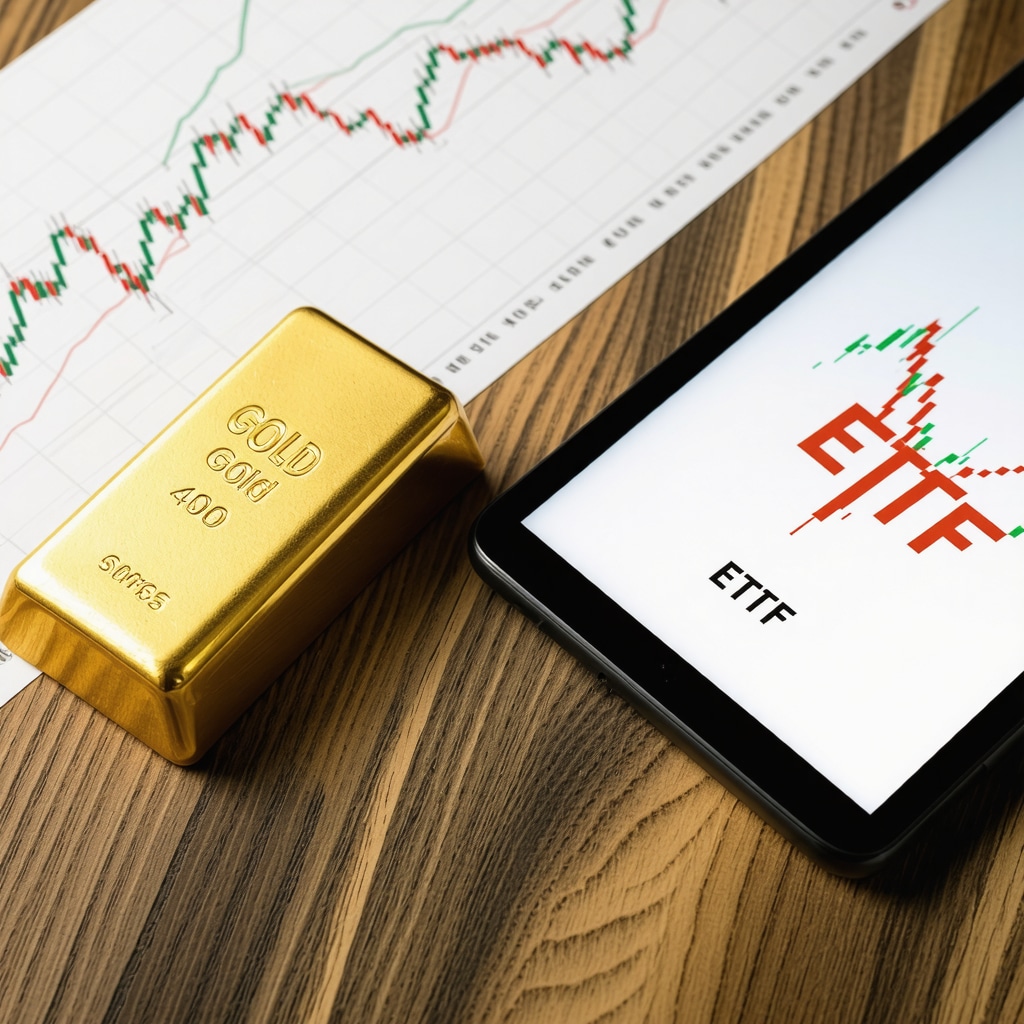Unlocking the Golden Vault: Why Gold Remains a Timeless Investment
In an era marked by market volatility and geopolitical uncertainty, gold continues to shine as a bastion of financial security. But with diverse options like ETFs, stocks, and physical bullion available, how can investors discern which gold investment suits their portfolio best? This exploration goes beyond the surface, offering an expert lens on the multifaceted world of gold investments.
Golden ETFs: Digital Convenience Meets Market Agility
Gold Exchange-Traded Funds (ETFs) have revolutionized access to gold exposure without the hassle of physical storage. They offer liquidity, transparency, and the ability to trade gold shares as easily as stocks. For instance, investors seeking portfolio diversification with minimal entry barriers often find ETFs appealing. However, understanding nuances such as management fees, tracking accuracy, and counterparty risks is essential for maximizing benefits.
Are Gold ETFs Truly a Safe Haven Compared to Physical Gold?
While gold ETFs provide convenience and ease of trading, they do not offer the tangible security of physical gold ownership. ETFs are subject to market risks and depend on the fund’s structure and custodian reliability. Conversely, physical bullion—gold bars or coins—ensures direct ownership, immune to digital platform vulnerabilities. Yet, physical gold demands secure storage and insurance, adding to total investment costs. This trade-off highlights the importance of aligning investment choices with individual risk tolerance and investment horizon.
Mining Stocks: Harnessing Growth Potential Amid Market Fluctuations
Investing in gold mining stocks introduces an equity element to gold exposure. These stocks can amplify returns during bullish gold markets but come with operational and geopolitical risks tied to mining companies. For example, a well-managed mining company with efficient extraction technology could outperform the gold price itself, offering capital appreciation beyond physical bullion or ETFs. Nevertheless, stock valuations may be influenced by broader stock market sentiments, making them less of a pure gold play.
Physical Bullion: The Tangible Core of Gold Wealth
Physical gold—bullion bars and coins—remains the most traditional form of gold investment. It confers undeniable ownership and has intrinsic value independent of financial systems. Practical considerations include authentication, purity verification, and secure storage solutions. Investors often view physical bullion as a hedge against inflation and currency devaluation, especially during systemic financial disruptions.
For those interested in safely purchasing physical gold, resources like this comprehensive guide offer expert tips on authentication and secure acquisition strategies.
Strategic Synergy: Combining Gold Investment Types for Portfolio Resilience
Expert investors often blend ETFs, stocks, and physical bullion to balance liquidity, growth, and security. For instance, ETFs can provide quick market exposure, mining stocks can fuel growth, and bullion offers a stable hedge. This layered approach mitigates singular risks, aligning with diversified investment philosophies.
To deepen your understanding of how to tailor your portfolio with gold ETFs and physical gold, explore this insightful analysis that weighs the pros and cons in detail.
Engage with us: Share your experiences or questions about gold investing in the comments below—your insights enrich our community’s knowledge.
Authoritative insights on gold investment strategies can be found in reports by the World Gold Council, a leading source on global gold market dynamics and investment trends (World Gold Council Research).
Decoding Gold Market Sentiments: What Moves the Price Needle?
Understanding the drivers behind gold price fluctuations is essential for sophisticated investors aiming to optimize their portfolios. Global economic indicators, such as inflation rates, currency strength, and geopolitical tensions, significantly influence gold demand and pricing. For instance, when inflation expectations rise or fiat currencies weaken, gold often experiences increased buying interest as a safe haven asset. Conversely, periods of economic stability and rising interest rates may dampen gold’s appeal.
Moreover, central bank policies and purchases play a critical role. Many central banks actively manage their gold reserves to diversify foreign exchange holdings, impacting global supply and demand dynamics. The central bank gold purchases have been notably influential in recent years, supporting prices amid market turbulence.
Gold Futures and Options: Leveraging Sophistication for Strategic Gains
For investors with a higher risk appetite and advanced market knowledge, trading gold futures and options offers potent tools for hedging and speculation. Futures contracts allow locking in prices for future delivery, enabling protection against adverse price movements or capitalizing on anticipated trends. Options provide flexibility with the right, but not the obligation, to buy or sell gold at predetermined prices, facilitating strategic positioning in volatile markets.
However, these instruments demand rigorous risk management due to leverage and complexity. Investors must understand margin requirements, contract specifications, and market timing to avoid amplified losses. Resources such as expert guides on gold futures trading offer invaluable insights for mastering these sophisticated techniques.
How Can Investors Integrate Gold Futures into a Diversified Portfolio Without Excess Risk?
Integrating gold futures into a diversified portfolio requires a nuanced approach balancing potential returns against risk exposure. Investors should allocate only a small portion of their portfolio to futures trading, using it primarily as a hedge against inflation or currency risks rather than for speculative gains. Combining futures with physical gold and gold ETFs can provide layered protection, leveraging the liquidity of contracts while maintaining tangible asset backing.
Additionally, employing stop-loss orders and regularly reviewing market conditions can help mitigate downside risks. Education and disciplined trading strategies are paramount to harnessing the benefits of gold futures effectively.
Gold Stocks: Navigating Company Fundamentals and Market Trends
Beyond the general gold price, individual mining stocks respond to company-specific factors such as production costs, reserve quality, and management effectiveness. Investors analyzing gold stocks should scrutinize financial reports, operational efficiency, and geopolitical risks in mining regions. For example, companies with low-cost production and robust exploration pipelines tend to outperform during gold upswings.
To deepen your knowledge about gold stocks and their role in portfolio growth, consider reviewing comprehensive analyses on gold stock investing. This resource elaborates on selecting top-performing mining companies with sustainable competitive advantages.
Join the conversation: We invite you to share your strategies or questions about combining different gold investment vehicles. Your experiences can help refine approaches to gold investing in an ever-changing market.
For authoritative data and market analysis, the World Gold Council remains a premier source, offering extensive research on gold demand, investment trends, and price factors (World Gold Council Research).
Deciphering Complex Gold Price Drivers: Beyond Traditional Economic Indicators
While inflation rates, currency fluctuations, and geopolitical tensions are well-recognized factors influencing gold prices, an expert investor must delve deeper into subtler dynamics such as real interest rates, sovereign debt levels, and global liquidity trends. For instance, real interest rates—nominal interest rates adjusted for inflation—exert a powerful influence on gold’s opportunity cost. Negative real rates often spur gold demand as investors seek assets preserving purchasing power.
Furthermore, the interplay between major currencies, particularly the US dollar and emerging market currencies, can create complex feedback loops affecting gold valuations. The World Gold Council emphasizes that these multilayered macroeconomic variables require continuous monitoring to anticipate price movements effectively (World Gold Council: Real Rates and Gold).
Harnessing Advanced Portfolio Tactics: Incorporating Gold with Quantitative Models
Modern portfolio theory (MPT) advocates for diversification to optimize risk-adjusted returns, but integrating gold demands sophisticated quantitative approaches. Techniques such as mean-variance optimization often undervalue gold’s defensive properties under extreme market stress. Thus, experts incorporate stress testing and scenario analysis to evaluate gold’s performance during tail-risk events like financial crises or geopolitical shocks.
Additionally, factor investing models that include momentum, value, and volatility factors can be adapted to gold assets. For example, momentum strategies might capitalize on trending gold price movements, while value-oriented approaches assess fundamental supply-demand imbalances in the gold market. Employing these models enhances portfolio resilience and exploits gold’s unique risk-return profile beyond traditional allocations.
How Can Sophisticated Investors Balance Gold Exposure Amid Macro Uncertainty?
Balancing gold exposure amid macroeconomic uncertainty involves a dynamic allocation strategy that adjusts to evolving market conditions rather than fixed percentages. Advanced investors utilize tactical asset allocation frameworks informed by leading economic indicators and sentiment analysis. This includes monitoring central bank signals, inflation breakevens, and geopolitical risk indices to modulate gold holdings proactively.
Moreover, integrating alternative data sources such as futures positioning, ETF flows, and mining production trends can provide early signals for adjusting gold exposure. This multi-dimensional approach requires continuous data synthesis and expert judgment to navigate the complexities of gold investing effectively.
Risk Management and Regulatory Considerations in Sophisticated Gold Trading
Engaging in sophisticated gold trading instruments such as derivatives necessitates a rigorous understanding of regulatory frameworks and counterparty risks. For example, futures and options markets are regulated by bodies like the Commodity Futures Trading Commission (CFTC) in the United States, mandating compliance with margin requirements and reporting standards.
Moreover, geopolitical events can abruptly change regulatory landscapes, impacting gold import-export policies, taxation, and market accessibility. Therefore, investors must maintain vigilance over evolving regulations and incorporate compliance strategies within their risk management frameworks.
Employing advanced risk controls such as value-at-risk (VaR), stress testing, and scenario analysis tailored to gold market specifics helps mitigate potential losses and preserve capital integrity.
Engage with our expert community: Share your sophisticated gold investment strategies or inquire about advanced portfolio integration techniques in the comments. Collaborate to refine your approach and stay ahead in the complex gold market.
Unveiling the Macro-Financial Tapestry Behind Gold’s Market Movements
Beyond traditional economic indicators, gold’s price trajectory is intricately influenced by a web of macro-financial variables. Sophisticated investors examine the interrelations between sovereign debt trajectories, central bank liquidity expansions, and global currency reserve shifts to anticipate subtle market inflections. For instance, the persistent accumulation of gold by emerging market central banks signals shifts in global reserve diversification, directly impacting supply-demand equilibrium.
Additionally, the juxtaposition of real interest rates against inflation expectations creates nuanced opportunity costs that dynamically alter gold’s attractiveness as a store of value. Recognizing these multilayered forces requires continuous macroeconomic monitoring and integration of high-frequency data analytics.
How Do Central Bank Gold Reserves Influence Long-Term Gold Price Stability?
Central banks act as pivotal custodians in the gold ecosystem, with their reserve management strategies profoundly shaping long-term price stability. Large-scale acquisitions or disposals can recalibrate market sentiment and liquidity conditions. According to the World Gold Council’s Central Bank Reserves Report, coordinated buying by central banks often underpins gold’s resilience during systemic shocks, reinforcing its status as a strategic asset.
Moreover, transparency in central bank reporting enhances market predictability, while opaque reserve policies introduce volatility. Hence, monitoring central bank activity is indispensable for portfolio managers seeking to anticipate macro-driven gold price movements.
Leveraging Quantitative Models and Alternative Data to Optimize Gold Allocation
Integrating gold into portfolios through quantitative frameworks transcends simple allocation heuristics. Advanced investors employ machine learning algorithms to analyze alternative data streams such as futures positioning, ETF inflows, and mining production anomalies. These models detect emergent trends and regime shifts, enabling proactive tactical adjustments.
For example, sentiment analysis derived from news feeds and social media sentiment can complement traditional economic indicators, providing early warning signals of potential gold market inflections. Incorporating these insights within a dynamic asset allocation model enhances portfolio robustness against macroeconomic shocks.
Compliance and Risk Mitigation in Sophisticated Gold Derivatives Trading
Engagement in gold derivatives demands unwavering adherence to regulatory frameworks and an intricate understanding of counterparty and liquidity risks. Risk officers must ensure compliance with mandates from regulatory bodies like the Commodity Futures Trading Commission (CFTC) and the European Securities and Markets Authority (ESMA), which oversee margin requirements, position limits, and reporting obligations.
Implementing advanced risk management protocols such as scenario-based stress testing and real-time value-at-risk (VaR) monitoring tailored to gold derivatives portfolios is critical. This discipline safeguards capital and maintains operational resilience amid volatile market conditions.
Engage with our expert community: Share your advanced gold investment methodologies or pose intricate questions on portfolio integration and risk frameworks. Collaborate to refine your expertise and remain at the forefront of sophisticated gold investing.
Frequently Asked Questions (FAQ)
What are the main differences between investing in gold ETFs and physical gold?
Gold ETFs offer liquidity, ease of trading, and cost efficiency without the need for physical storage, making them accessible for many investors. Physical gold provides direct ownership, immune to counterparty or digital platform risks, but requires secure storage and insurance. The choice depends on investment goals, risk tolerance, and preferences regarding tangibility versus convenience.
How do gold mining stocks compare to other forms of gold investment?
Gold mining stocks provide exposure to both the gold price and company-specific factors such as operational efficiency, reserves, and management quality. They can offer higher growth potential but carry additional risks including geopolitical issues and market volatility unrelated to gold prices. Mining stocks are less of a pure gold hedge and more akin to equity investments.
Can gold futures and options be suitable for average investors?
Gold futures and options are sophisticated instruments best suited for experienced investors with a deep understanding of market mechanics and risk management. They allow hedging and speculative strategies with leverage but require rigorous discipline to avoid significant losses. For most investors, a modest allocation combined with education and expert guidance is recommended.
How should investors approach portfolio allocation involving gold during uncertain economic periods?
During macroeconomic uncertainty, dynamic allocation that adjusts to evolving indicators such as inflation expectations, real interest rates, and geopolitical risks is optimal. Combining physical gold, ETFs, and selective mining stocks can balance liquidity, growth, and security. Incorporating quantitative models and alternative data enhances responsiveness to market shifts.
What role do central bank gold reserves play in influencing gold prices?
Central banks significantly impact gold prices through their reserve management strategies. Large-scale purchases can support prices and signal confidence, while sales may introduce volatility. Transparency in reporting helps market predictability. Monitoring central bank activity is crucial for understanding long-term price trends and market sentiment.
How can advanced investors use quantitative models to optimize gold exposure?
Advanced investors integrate machine learning, sentiment analysis, and alternative data such as ETF flows and futures positioning to identify trends and regime changes. These models facilitate tactical adjustments beyond static allocation, improving risk-adjusted returns and portfolio resilience against tail risks and macro shocks.
What are the key regulatory considerations when trading gold derivatives?
Gold derivatives trading is subject to regulations by bodies like the CFTC and ESMA, including margin requirements, position limits, and reporting obligations. Compliance is essential to manage counterparty and liquidity risks. Employing advanced risk management tools such as VaR and stress testing tailored to gold markets helps ensure regulatory adherence and capital protection.
Is combining different gold investment vehicles beneficial?
Yes, combining ETFs, mining stocks, physical bullion, and derivatives can create a synergistic portfolio that balances liquidity, growth potential, and stability. This diversification mitigates risks inherent in any single investment type and aligns with sophisticated investment philosophies seeking resilience amid market volatility.
What should beginners know before investing in gold?
Beginners should understand gold’s role as a hedge against inflation and currency risk, the differences between investment vehicles, and the importance of secure storage for physical gold. Starting with ETFs or small physical holdings can provide exposure while minimizing complexity. Education on market drivers and risks is critical before advancing to more complex instruments.
How important is monitoring macroeconomic indicators for gold investors?
Monitoring indicators like inflation rates, real interest rates, currency movements, and geopolitical developments is vital. These factors directly influence gold demand and price. Sophisticated investors integrate these insights with alternative data and market sentiment to anticipate price movements and adjust portfolios proactively.
Trusted External Sources
- World Gold Council (WGC): Offers comprehensive research on global gold market dynamics, investment trends, central bank activities, and macroeconomic impacts. Its authoritative reports and data sets underpin expert understanding of gold’s multifaceted role in portfolios (WGC Research Hub).
- Commodity Futures Trading Commission (CFTC): Regulatory body overseeing futures and options markets in the U.S., providing essential information on compliance, margin rules, and market transparency critical for derivatives trading (CFTC Official Site).
- International Council on Mining and Metals (ICMM): Provides insights on mining company standards, operational risks, and sustainable practices, aiding investors evaluating gold mining equities (ICMM).
- Bloomberg Terminal and Financial Data Providers: Deliver real-time market data, futures positioning, ETF flows, and macroeconomic indicators, enabling sophisticated quantitative modeling and sentiment analysis for gold investors.
- Academic Journals on Financial Economics and Portfolio Theory: Sources like the Journal of Portfolio Management and Financial Analysts Journal publish seminal research on gold’s role in diversification, risk management, and quantitative investment strategies.
Conclusion
Gold remains a cornerstone of diversified investment strategies due to its unique blend of security, liquidity, and growth potential. Whether through ETFs, mining stocks, physical bullion, or sophisticated derivatives, each vehicle offers distinct advantages and considerations. Expert investors harness a layered approach, integrating macroeconomic insights, quantitative models, and dynamic risk management to optimize gold’s role amid evolving market conditions.
Understanding the interplay between central bank policies, economic indicators, and gold market sentiment empowers investors to anticipate price movements and tailor allocations effectively. Regulatory awareness and disciplined strategies further safeguard capital in complex trading environments.
By embracing a comprehensive and informed perspective on gold investments, investors can enhance portfolio resilience and capitalize on gold’s timeless appeal as a strategic asset.
We encourage you to share your thoughts, questions, or experiences below and explore our related expert content to deepen your mastery of gold investing.











The discussion about balancing between gold ETFs, mining stocks, and physical bullion really hits home for me. I started my gold investment journey with ETFs because I appreciated the liquidity and ease of entry without the hassle of storing physical gold. However, I quickly realized that ETFs carry counterparty risks that investors sometimes overlook. Recently, I’ve incorporated physical bullion into my portfolio as a hedge against digital platform vulnerabilities and economic uncertainty, but the costs and logistics of secure storage have been a learning curve. Mining stocks, while offering exposure to company growth, introduced a different risk dimension tied to operational and geopolitical factors, which made me more cautious. What I find particularly valuable is the layered approach mentioned in the article—combining different gold vehicles to balance liquidity, growth potential, and safety. I’m curious, for investors who have diversified their gold holdings this way, how do you manage the trade-offs between these investment types over time? Do you adjust allocations based on macroeconomic indicators or stick to a strategic, long-term balance? I’d love to hear about different practical strategies from the community.